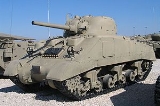
Postwar Sherman tanks
Encyclopedia
Sherman tanks saw extensive use around the world after World War II
. This article catalogues foreign post–World War II use and conversions of Sherman tanks and variants based on the Sherman chassis.
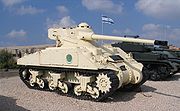
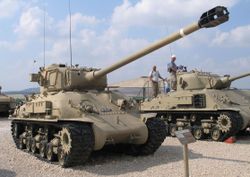
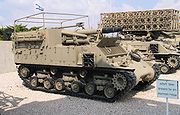
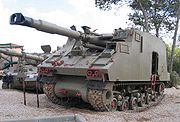
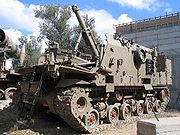
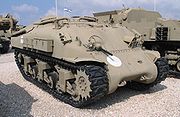
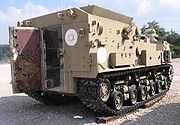
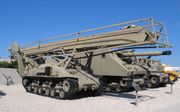
for rocket/missile tank photos.
for TRV/ARV photo.
A Canadian company, Morpac Industries, Inc.http://www.morpac.com/index.shtml, still produces heavy-duty, off-road load carriers based on Sherman components. These vehicles are used in the construction of electricity transmission lines in remote areas.
In 1947 Vickers
produced the Shervick which was a Sherman chassis converted into a heavy tractor. It was designed to be used in East Africa to clear land for peanut farming as part of the Tanganyika groundnut scheme
.
operated a squadron of US-loaned M4A3(76)W HVSS in the Korean War. The Shermans were replaced in the Regular Force with the Centurion in the late 1950s, and remained in use in reserve armoured regiments until 1970.
Canada used Grizzly/Skink Kangaroo APC variants into the 1950s and beginning in 1954 transferred at least 40 to Portugal, some of which were found in a Portuguese scrapyard in 1995. When Canada's post–World War II M4A2(76)W HVSS Shermans were obsolete, it also converted some to Kangaroos and used them into the 1960s until replacement by M113s. A proposed purpose-built Canadian armored vehicle, the Bobcat
, never materialized.
, which followed, in the generally mountainous terrain where fighting invariably took place, like at the battle of Mount Grammos in 1949, the favoured tank was the lighter British Centaur, or "Kentavros" in Greek, a variation of the Cromwell tank
, a few of which were made available earlier to the National Army.[However, it should be noted that , at least until 1985 two Sherman turrets , probably M4A2,single hatch version,minus the guns and set on concrete bases as improvised bunkers,could be seen in the Greek Army's School for Army Engineers at Loutraki,their presence at odds with the commonly accepted view that the Greek Army used only recovery vehicles based on the Sherman and not gun tanks. Recently digitized footage indicates the use of at least one Sherman Tankdozer, probably a M4A4, by the Hellenic Army seen during a visit to Greece by General Eisenhower (see links section below).] Italy used Shermans with 75 mm and 17 pdr gun and 105 mm howitzer. Portugal, Denmark, and Yugoslavia used E4 Shermans, which had the retro-fitted US 76 mm gun. Belgium and The Netherlands used the A1, A2 and Fireflies until the late fifties; the howitzer version was much longer in use: the Dutch Marine Corps only phased them out in the late seventies. France used numerous Shermans till the early fifties; these were then partly taken over by the Gendarmerie
who employed them during the various (attempted) coups of 1961 and 1962.
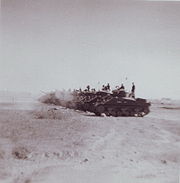 British India possessed a number of Shermans at the time of the 1947 Partition and the M4 found itself in both Indian and Pakistani inventories. In the 1960s, India operated M4A3 and M4A4 both with 76 mm gun and some Sherman displayed as war monuments in India are still equipped with French CN 75-50 75 mm gun (as used in the French AMX 13 light tank). Pakistan received E4 Shermans, which had the retro-fitted US 76 mm gun. At the time of the 1965 Indo-Pakistan War, Pakistan owned 200 Shermans re-armed with 76 mm guns. The Sherman fought on both sides of the Second Kashmir War and Indo-Pakistani War of 1971
British India possessed a number of Shermans at the time of the 1947 Partition and the M4 found itself in both Indian and Pakistani inventories. In the 1960s, India operated M4A3 and M4A4 both with 76 mm gun and some Sherman displayed as war monuments in India are still equipped with French CN 75-50 75 mm gun (as used in the French AMX 13 light tank). Pakistan received E4 Shermans, which had the retro-fitted US 76 mm gun. At the time of the 1965 Indo-Pakistan War, Pakistan owned 200 Shermans re-armed with 76 mm guns. The Sherman fought on both sides of the Second Kashmir War and Indo-Pakistani War of 1971
.
The Japan Self Defense Forces received 250 M4A3(76)W HVSS and 80 M32 TRV IN 1954. The indigenous Type 61 only slowly replaced American tanks over the 1960s.
The Philippine Army was another postwar Asian user of the M4 Sherman.
M4 Sherman
s as early as in the 1948 war
. The first one, nicknamed Meir, was obtained in May 1948; the British Army intended it for destruction, but soldiers handed it over to Hagana instead. One more was found at scrapyard. In November 1948 30 more were purchased from Italian scrapyards. All these were non-operational, only 4 were completely repaired until the end of the war and 14 by November (some necessitated re-arming with the Krupp 75 mm field gun). By late 1953 Israel had 76 operational Shermans and 131 non-operational. In March 1956, Israel began to upgrade Shermans with French CN 75-50 75 mm guns to create the Sherman M-50. The first 25 M-50s were finished just in time for the October 1956 Operation Kadesh in the Sinai against the Egyptian Army
. The first 50 M-50 tanks had Continental R-975 gasoline engine and VVSS suspension, the rest had Cummins
diesel engine
and HVSS suspension. In 1960s, 180 M4A1(76) Sherman tanks began conversion to the diesel Sherman M-51 with HVSS and French CN 105 F1 105 mm gun. Both M-50 and M-51 saw combat in the Six-Day War
and also were employed in the 1973 Yom Kippur War
. M-50 Continental were retired by 1972. M-50 Cummins and M-51 were gradually phased out in late 1970s to early 1980s. In total, about 620 Sherman tanks were purchased by Israel in 1948-1967.
Egypt acquired M4A4 and fitted them with the diesel engine of M4A2 and the FL-10 turret of the French AMX-13
light tank. Syria possessed at least one M4A1 chassis at some time during 1948-1956.
acquired a number of ex-Israeli M4A1(76)W with both VVSS and HVSS and at least some with smoke dischargers and used them during the Idi Amin
regime.
an army acquired ex-Israeli Shermans to convert to their M-60 variant with 60 mm HVMS gun. Chile used Shermans into 1989, and some claim that Paraguay
was the last country in Latin America to use the Sherman tank (Paraguayan Sherman). After Mexico signed the 1947 Rio Treaty it received 25 Sherman tanks and in 1998 it upgraded its Sherman-chassis M32 Chenca TRV.
In Central America
, Nicaragua
used the M4A3 Sherman. It was in Nicaragua were most likely the Sherman saw action for the last time, during the Sandinista Revolution in 1978-79, Nicaragua's National Guard
made use of their tanks in urban warfare
against the insurrection. After the Sandinistas took power the new Nicaraguan Army soon received Russian made tanks and the Shermans disappeared from the scene.
World War II
World War II, or the Second World War , was a global conflict lasting from 1939 to 1945, involving most of the world's nations—including all of the great powers—eventually forming two opposing military alliances: the Allies and the Axis...
. This article catalogues foreign post–World War II use and conversions of Sherman tanks and variants based on the Sherman chassis.
US foreign aid variants
- E4 Sherman - Perhaps the last US-made Sherman variants, in the early 1950s US Ordnance depots or private contractors mounted the 76 mm gun in the original, small turret of M4A3 and M4A1. The US provided these M4A3E4(76) or M4A1E4(76) to allies in Europe and Asia.
- HVSS - The US also retro-fitted the late-World War II wider-tracked HVSS suspension to many Shermans and this is sometimes noted after the main vehicle designation.
Canadian variants
- Sherman Badger - CanadaCanadaCanada is a North American country consisting of ten provinces and three territories. Located in the northern part of the continent, it extends from the Atlantic Ocean in the east to the Pacific Ocean in the west, and northward into the Arctic Ocean...
's replacement of its Ram Badger Flame tankFlame tankA flame tank is a type of tank equipped with a flamethrower, most commonly used to supplement combined arms attacks against fortifications, confined spaces, or other obstacles...
, the Sherman Badger was a turretless M4A2 HVSS Sherman with Wasp IIC flamethrower in place of hull machine gun, developed sometime from 1945 to 1949. The 150 gallons at 250 psi was effective to 125 yards, with elevation of +30 to -10 degrees and traverse of 30 degrees left and 23 degrees right. This inspired the US T68. - Sherman Kangaroo - From late World War II to the 1960s, Canada converted/used some Grizzlies (M4A1 Shermans made in Canada with different tracks and radios in 1943), at least one very similar Skink (prototype Anti-aircraft-gun on the Grizzly hull), and M4A2(76)W HVSS Shermans to Kangaroo armored personnel carriers (APCs).
Mexican variants
- M32 Chenca - In 1998, Napco International of the USA upgraded M32B1 TRV Sherman-chassis armoured recovery vehicleArmoured recovery vehicleAn armoured recovery vehicle is a type of armoured fighting vehicle used to repair battle- or mine-damaged as well as broken-down armoured vehicles during combat, or to tow them out of the danger zone for more extensive repairs...
s with Detroit Diesel 8V-92-T diesel engines.
Indian variants
- Sherman VA/M4A4(76) - although never a US production type (the 1950s E4 conversion was limited to M4A1 and M4A3), at least one source claims that India had one regiment partly equipped with Sherman V ( British/Indian designation of M4A4) with 76 mm guns (the US 76 mm is not specified but British practice added an A suffix to denote the 76 mm).
- Upgunned Sherman - two regiments of Shermans re-armed with the French 75 mm gun (derivative of the German Panther tank's gun) and referred to as upgunned Shermans.
Argentine variants
- Repotenciado - Conversions of British Sherman VC and IC Hybrid to include a diesel engine and a new armament suite, the 105 mm FTR L44/57 gun (an Argentine copy of the CN-105-57 GunCN-105-57CN-105-57 is a French 105 mm tank gun of 57 calibre length.The CN-105-57 notably equipped some variants of the AMX-13 and the SK-105 Kurassier.Argentina produced a version for use on their TAM medium tank which equipped its later models....
used on the AMX-13), a co-axial MAG-58 machine gun, and turret pintle mounted M2HB machine gun. (Side view of an argentinian Sherman "repotenciado").

Chilean variants
- M50/60 - Converted Israeli M50 Shermans, refitted with the IMI-OTO 60mm Hyper Velocity Medium Support (HVMS) gun. Claimed to be the very last fighting Sherman, remaining in Chilean service until 1989, when it was replaced by the Leopard 1V and AMX-30B2.
Egyptian variants
- M4A4 with FL-10 Turret - M4A4 fitted with the diesel engine of M4A2 and the FL-10 turret of the French AMX-13AMX-13The AMX-13 is a French light tank produced from 1953 to 1985. It served with the French Army and was exported to over twenty-five other nations...
light tank.
Israeli variants







Gun tanks
- Sherman (Krupp) - Six early salvaged Shermans had a KruppKruppThe Krupp family , a prominent 400-year-old German dynasty from Essen, have become famous for their steel production and for their manufacture of ammunition and armaments. The family business, known as Friedrich Krupp AG Hoesch-Krupp, was the largest company in Europe at the beginning of the 20th...
75 mm field gun to replace the original gun destroyed during post–World War II scrapping. Later these tanks were rearmed with 105 mm M4 howitzers. - Sherman M-1 - Israeli designation of any Sherman model armed with the 76 mm gun M1.
- Super Sherman M-1 - Israeli designation of M4A1(76) fitted with HVSS suspension.
- Sherman M-3 (Sherman degem Alef prior to 1956) - Israeli designation of any Sherman model armed with the 75 mm gun M375 mm Gun (US)The US 75 mm gun tank gun M2 and the later M3 were the standard American tank guns of the Second World War.Besides use on the two main American medium tanks of the war the M3 Lee and the M4 Sherman . The lightweight M6 and M5 variants were developed to equip the Light Tank M24 and the B-25...
. - Sherman M-4 (Sherman degem Bet prior to 1956) - Israeli designation of any Sherman model armed with the 105 mm howitzer M4.
- Sherman M-50M50 Super ShermanThe Sherman M-50 and the Sherman M-51, both known abroad as the Super Sherman, were modified versions of the American M4 Sherman tank that served with the Israel Defense Forces from the mid-1950s to early 1980s. The M-51 was also referred to as the Isherman...
- Upgraded Sherman with the French CN 75-50 75 mm gun, as used in the French AMX 13 light tank, in the "old" turret fitted with a counterweight. Entered service in 1956. Was used in the Suez CrisisSuez CrisisThe Suez Crisis, also referred to as the Tripartite Aggression, Suez War was an offensive war fought by France, the United Kingdom, and Israel against Egypt beginning on 29 October 1956. Less than a day after Israel invaded Egypt, Britain and France issued a joint ultimatum to Egypt and Israel,...
(1956), the Six Days War (1967) and the Yom Kippur WarYom Kippur WarThe Yom Kippur War, Ramadan War or October War , also known as the 1973 Arab-Israeli War and the Fourth Arab-Israeli War, was fought from October 6 to 25, 1973, between Israel and a coalition of Arab states led by Egypt and Syria...
(1973). Sometimes colloquially mis-named as Super Sherman.- M-50 Continental - subvariant with Continental R-975 gasoline engine and VVSS suspension. 50 units converted.
- M-50 Cummins - subvariant with CumminsCumminsCummins Inc. is a Fortune 500 corporation that designs, manufactures, distributes and services engines and related technologies, including fuel systems, controls, air handling, filtration, emission control and electrical power generation systems...
diesel engine and HVSS suspension.
- Sherman M-51M50 Super ShermanThe Sherman M-50 and the Sherman M-51, both known abroad as the Super Sherman, were modified versions of the American M4 Sherman tank that served with the Israel Defense Forces from the mid-1950s to early 1980s. The M-51 was also referred to as the Isherman...
- Upgraded M4A1 (HVSS) with improved engine and T23 turret modified to fit a shortened variant of the French CN 105 F1 gun with large muzzle brake. Was used in the Six Days War and the Yom Kippur War. Sometimes colloquially referred to as Isherman. About 100 of the remaining tanks of this model were sold to Chile in late 70's, were they received a new engine and transmission in early 90's. All of them were replaced by ex-Dutch Leopard 1V in late 90's
Artillery tanks
See Rocket artilleryRocket artillery
Rocket artillery is a type of artillery equipped with rocket launchers instead of conventional guns or mortars.Types of rocket artillery pieces include multiple rocket launchers.-History:...
for rocket/missile tank photos.
- M-50 155 mm - The M-50 was an open structured self-propelled artillery piece, mounting a single French Model 50 155 mm howitzerObusier de 155 mm Modèle 50Obusier de 155 mm Modèle 50 was a French 155 mm 30 calibre howitzer of Cold War era that remained in service with some nations until the 1990s. The gun has a split trail, large slotted muzzle-break, four-wheeled bogie and a retractable firing pedestal beneath the axles...
at the back of the hull, which was based on the "long" hull of M4A4 fitted with Continental engine (late production vehicles possibly used "short" hulls from other variants). The gun was developed in early 1960s by Israeli Ordnance CorpsIsraeli Ordnance CorpsThe Israeli Ordnance Corps is a combat-support corps in the IDF GOC Army Headquarters. Before the Israeli Technological and Logistics Directorate was dismantled, it fell under its jurisdiction. The corps is responsible for the development and maintenance of war materiel, combat-support materials,...
in cooperation with France. Probably about 120 units were produced. In early 1970s M-50s were fitted with HVSS and Cummins diesel engines. Was used in the War of AttritionWar of AttritionThe international community and both countries attempted to find a diplomatic solution to the conflict. The Jarring Mission of the United Nations was supposed to ensure that the terms of UN Security Council Resolution 242 would be observed, but by late 1970 it was clear that this mission had been...
and the Yom Kippur War. Some reserve units were armed with the M-50 at least until late 1970s. - Ro'em (colloquially known as L-33) - A self-propelled artillery piece mounting Soltam M-68Soltam M-68The M-68 was a 155 mm 33 calibre towed gun howitzer manufactured by Soltam Systems of Israel. The barrel of the M-68 is 5.18 m long and comes with a simple muzzle brake at the mouth of the barrel, the recoil mechanism of the two pneumatic cylinder jacks is positioned on the back-end of the...
155 mm L/33 howitzer in large enclosed superstructure. Uses Sherman chassis with Cummins VT-8-460Bi diesel engine and HVSS. Probably about 200 units were produced. The gun saw combat in the Yom-Kippur War and the 1982 Lebanon War1982 Lebanon WarThe 1982 Lebanon War , , called Operation Peace for Galilee by Israel, and later known in Israel as the Lebanon War and First Lebanon War, began on 6 June 1982, when the Israel Defense Forces invaded southern Lebanon...
. Currently out of active service. - L-39 - Like L-33, but with longer (39 calibers) barrelSoltam M-71The M-71 is a 155 mm 39 calibre towed howitzer manufactured by Soltam, Israel.-Design:The weapon was based on the earlier Soltam M-68 and uses the same recoil system, breech and carriage but had a longer gun barrel...
. Apparently it was not adopted. - Makmat 160 mm - Soltam M-66Soltam M-66M-66 is a 160 mm mortar manufactured by Soltam of Israel. The weapon was based on an earlier design of the 160mm M-58 mortar by Vammas of Finland...
160 mm mortar mounted on a Sherman chassis, in an open-topped compartment with folding front plate. It was adopted in 1968 and used in the War of Attrition, the Yom Kippur War and the 1982 Lebanon War. - MAR-240 - In place of the turret, a side-looking launcher for 36 240 mm rockets was fitted. These were Israeli made copies of the Soviet rockets used by the BM-24BM-24The BM-24 is a multiple rocket launcher designed in the Soviet Union. It is capable of launching 240mm rockets from 12 launch tubes. Versions of the BM-24 have been mounted on the ZIL-151 6x6 Truck chassis and the AT-S tracked artillery tractor....
multiple launch rocket system. Apparently never reached mass production. MAR stands for Medium Artillery Rocket. - Episkopi - Similar to MAR-240, but mounting a back-looking launcher for four 290 mm ground-to-ground rockets with high-explosive/fragmentation (Ivry-1) or cluster (Haviv) warhead. Was adopted in 1973, saw combat for the first time in the 1982 Lebanon War. Is colloquially known as MAR-290, and the name Ivry is also sometimes applied to the launching vehicle. An improved launcher on the Centurion tankCenturion tankThe Centurion, introduced in 1945, was the primary British main battle tank of the post-World War II period. It was a successful tank design, with upgrades, for many decades...
chassis was later developed, but remained experimental. In 1990s was replaced in active service by the M270 MLRSM270 Multiple Launch Rocket SystemThe M270 Multiple Launch Rocket System is an armored, self-propelled, multiple rocket launcher; a type of rocket artillery.Since the first M270s were delivered to the U.S. Army in 1983, the MLRS has been adopted by several NATO countries. Some 1,300 M270 systems have been manufactured in the...
. - Kilshon (Trident) or Kachlilit - The Kilshon was developed to reduce the losses suffered by SAM suppression aircraft by launching anti-radiation missileAnti-radiation missileAn anti-radiation missile is a missile which is designed to detect and home on an enemy radio emission source. Typically these are designed for use against an enemy radar, although jammers and even radios used for communication can also be targeted in this manner.- Air-to-Ground :Most ARM designs...
s from the ground. The Kilshon was based on turretless hull of the Sherman M-51 on which a AGM-45 ShrikeAGM-45 ShrikeAGM-45 Shrike is an American anti-radiation missile designed to home in on hostile antiaircraft radars. The Shrike was developed by the Naval Weapons Center at China Lake in 1963 by mating a seeker head to the rocket body of an AIM-7 Sparrow. It was phased out by U.S...
anti-radiation missile launcher was mounted. To deliver the desired range, a specially modified AGM-45 with booster was used. Later a prototype was developed for use with the AGM-78 StandardAGM-78 Standard ARMThe AGM-78 Standard ARM was an anti-radiation missile developed by General Dynamics, United States of America.-Overview:Originally developed for the US Navy during the late 1960s, the AGM-78 was created in large part because of the limitations of the AGM-45 Shrike, which suffered from a small...
anti-radiation missile, but with the retirement of Shermans from IDF service the Keres (Hook) system was placed onto a heavy truck chassis for the finalized design instead.
Support tanks
See Armoured recovery vehicleArmoured recovery vehicle
An armoured recovery vehicle is a type of armoured fighting vehicle used to repair battle- or mine-damaged as well as broken-down armoured vehicles during combat, or to tow them out of the danger zone for more extensive repairs...
for TRV/ARV photo.
- Sherman Morag - Israeli designation of Sherman Crab.
- Trail Blazer (Gordon) - A recovery/engineering vehicle based on HVSS equipped M4A1s, it featured a large single boom crane (as opposed to the A-Frame of the M32) and large spades at the front and rear of the vehicle to assist in lifting. It could also tow up to 72 tons.
- Sherman Medical Evacuation Tank (Ambutank) - A radical conversion of the M4 with the turret removed and the powerplant (changed to a diesel engine) moved to the front of the tank. A medical team and four casualties could be carried in an armoured compartment at the rear. Early vehicles were based on M4A1 hulls with VVSS suspension and are often referred to as "VVSS version". Later vehicles used hulls with HVSS suspension and were fitted with a big boxy superstructure. This version is often referred to as "HVSS version". Many were used during the Israeli-Egyptian War of AttritionWar of AttritionThe international community and both countries attempted to find a diplomatic solution to the conflict. The Jarring Mission of the United Nations was supposed to ensure that the terms of UN Security Council Resolution 242 would be observed, but by late 1970 it was clear that this mission had been...
(1968–70) and the Yom Kippur War. - Eyal Observation Post Vehicle - A Sherman that had the turret replaced with a 27 m (90 foot) tall hydraulically erected observation platform. This was used near the Suez CanalSuez CanalThe Suez Canal , also known by the nickname "The Highway to India", is an artificial sea-level waterway in Egypt, connecting the Mediterranean Sea and the Red Sea. Opened in November 1869 after 10 years of construction work, it allows water transportation between Europe and Asia without navigation...
as a mobile observation post, before the Yom Kippur WarYom Kippur WarThe Yom Kippur War, Ramadan War or October War , also known as the 1973 Arab-Israeli War and the Fourth Arab-Israeli War, was fought from October 6 to 25, 1973, between Israel and a coalition of Arab states led by Egypt and Syria...
.
Civilian variants
After World War II, demilitarized Shermans were widely available and relatively cheap. Many were heavily modified for use in the construction, forestry and mining industries. Often, the turret and upper hull were completely removed and replaced with whatever equipment that was required for the vehicle's new role.A Canadian company, Morpac Industries, Inc.http://www.morpac.com/index.shtml, still produces heavy-duty, off-road load carriers based on Sherman components. These vehicles are used in the construction of electricity transmission lines in remote areas.
In 1947 Vickers
Vickers
Vickers was a famous name in British engineering that existed through many companies from 1828 until 1999.-Early history:Vickers was formed in Sheffield as a steel foundry by the miller Edward Vickers and his father-in-law George Naylor in 1828. Naylor was a partner in the foundry Naylor &...
produced the Shervick which was a Sherman chassis converted into a heavy tractor. It was designed to be used in East Africa to clear land for peanut farming as part of the Tanganyika groundnut scheme
Tanganyika groundnut scheme
The Tanganyika Groundnut Scheme was a plan to cultivate tracts of what is now Tanzania with peanuts. It was a project of the British Labour government of Clement Attlee. It was abandoned in 1951 at considerable cost to the taxpayers when it did not become profitable...
.
Canada
Canada left all its wartime Shermans in Europe, giving them to the Dutch and Belgian armies. In 1946, Canada purchased 300 M4A2 76mm (W) HVSS Shermans. Lord Strathcona's Horse (Royal Canadians)Lord Strathcona's Horse (Royal Canadians)
Lord Strathcona's Horse is a regular armoured regiment of the Canadian Forces. Currently based in Edmonton, Alberta, the regiment is part of Land Force Western Area's 1 Canadian Mechanized Brigade Group...
operated a squadron of US-loaned M4A3(76)W HVSS in the Korean War. The Shermans were replaced in the Regular Force with the Centurion in the late 1950s, and remained in use in reserve armoured regiments until 1970.
Canada used Grizzly/Skink Kangaroo APC variants into the 1950s and beginning in 1954 transferred at least 40 to Portugal, some of which were found in a Portuguese scrapyard in 1995. When Canada's post–World War II M4A2(76)W HVSS Shermans were obsolete, it also converted some to Kangaroos and used them into the 1960s until replacement by M113s. A proposed purpose-built Canadian armored vehicle, the Bobcat
Bobcat (armored personnel carrier)
The Bobcat was an armored personnel carrier designed and built in Canada in the 1950s and early 1960s. A lengthy development period and changing requirements drove the price up while not improving the basic design, and the project was eventually cancelled in late 1963 in favor of purchasing the...
, never materialized.
Europe
Greece was believed never to never used the Sherman tank, although several British Shermans were in action in Athens during the Communist insurrection of 1944, in support of government forces. During the Greek Civil WarGreek Civil War
The Greek Civil War was fought from 1946 to 1949 between the Greek governmental army, backed by the United Kingdom and United States, and the Democratic Army of Greece , the military branch of the Greek Communist Party , backed by Bulgaria, Yugoslavia and Albania...
, which followed, in the generally mountainous terrain where fighting invariably took place, like at the battle of Mount Grammos in 1949, the favoured tank was the lighter British Centaur, or "Kentavros" in Greek, a variation of the Cromwell tank
Cromwell tank
Tank, Cruiser, Mk VIII, Cromwell ,The designation as the eighth Cruiser tank design, its name given for ease of reference and its General Staff specification number respectively and the related Centaur tank, were one of the most successful series of cruiser tanks fielded by Britain in the Second...
, a few of which were made available earlier to the National Army.[However, it should be noted that , at least until 1985 two Sherman turrets , probably M4A2,single hatch version,minus the guns and set on concrete bases as improvised bunkers,could be seen in the Greek Army's School for Army Engineers at Loutraki,their presence at odds with the commonly accepted view that the Greek Army used only recovery vehicles based on the Sherman and not gun tanks. Recently digitized footage indicates the use of at least one Sherman Tankdozer, probably a M4A4, by the Hellenic Army seen during a visit to Greece by General Eisenhower (see links section below).] Italy used Shermans with 75 mm and 17 pdr gun and 105 mm howitzer. Portugal, Denmark, and Yugoslavia used E4 Shermans, which had the retro-fitted US 76 mm gun. Belgium and The Netherlands used the A1, A2 and Fireflies until the late fifties; the howitzer version was much longer in use: the Dutch Marine Corps only phased them out in the late seventies. France used numerous Shermans till the early fifties; these were then partly taken over by the Gendarmerie
Gendarmerie
A gendarmerie or gendarmery is a military force charged with police duties among civilian populations. Members of such a force are typically called "gendarmes". The Shorter Oxford English Dictionary describes a gendarme as "a soldier who is employed on police duties" and a "gendarmery, -erie" as...
who employed them during the various (attempted) coups of 1961 and 1962.
Asia

Indo-Pakistani War of 1971
The Indo-Pakistani War of 1971 was a military conflict between India and Pakistan. Indian, Bangladeshi and international sources consider the beginning of the war to be Operation Chengiz Khan, Pakistan's December 3, 1971 pre-emptive strike on 11 Indian airbases...
.
The Japan Self Defense Forces received 250 M4A3(76)W HVSS and 80 M32 TRV IN 1954. The indigenous Type 61 only slowly replaced American tanks over the 1960s.
The Philippine Army was another postwar Asian user of the M4 Sherman.
Middle East
The Israeli Defense Forces used AmericanUnited States
The United States of America is a federal constitutional republic comprising fifty states and a federal district...
M4 Sherman
M4 Sherman
The M4 Sherman, formally Medium Tank, M4, was the primary tank used by the United States during World War II. Thousands were also distributed to the Allies, including the British Commonwealth and Soviet armies, via lend-lease...
s as early as in the 1948 war
1948 Arab-Israeli War
The 1948 Arab–Israeli War, known to Israelis as the War of Independence or War of Liberation The war commenced after the termination of the British Mandate for Palestine and the creation of an independent Israel at midnight on 14 May 1948 when, following a period of civil war, Arab armies invaded...
. The first one, nicknamed Meir, was obtained in May 1948; the British Army intended it for destruction, but soldiers handed it over to Hagana instead. One more was found at scrapyard. In November 1948 30 more were purchased from Italian scrapyards. All these were non-operational, only 4 were completely repaired until the end of the war and 14 by November (some necessitated re-arming with the Krupp 75 mm field gun). By late 1953 Israel had 76 operational Shermans and 131 non-operational. In March 1956, Israel began to upgrade Shermans with French CN 75-50 75 mm guns to create the Sherman M-50. The first 25 M-50s were finished just in time for the October 1956 Operation Kadesh in the Sinai against the Egyptian Army
Egyptian Army
The Egyptian Army is the largest service branch within the Egyptian Armed Forces and holds power in the current Egyptian government. It is estimated to number around 379,000, in addition to 479,000 reservists for a total of 858,000 strong. The modern army was created in the 1820s, and during the...
. The first 50 M-50 tanks had Continental R-975 gasoline engine and VVSS suspension, the rest had Cummins
Cummins
Cummins Inc. is a Fortune 500 corporation that designs, manufactures, distributes and services engines and related technologies, including fuel systems, controls, air handling, filtration, emission control and electrical power generation systems...
diesel engine
Diesel engine
A diesel engine is an internal combustion engine that uses the heat of compression to initiate ignition to burn the fuel, which is injected into the combustion chamber...
and HVSS suspension. In 1960s, 180 M4A1(76) Sherman tanks began conversion to the diesel Sherman M-51 with HVSS and French CN 105 F1 105 mm gun. Both M-50 and M-51 saw combat in the Six-Day War
Six-Day War
The Six-Day War , also known as the June War, 1967 Arab-Israeli War, or Third Arab-Israeli War, was fought between June 5 and 10, 1967, by Israel and the neighboring states of Egypt , Jordan, and Syria...
and also were employed in the 1973 Yom Kippur War
Yom Kippur War
The Yom Kippur War, Ramadan War or October War , also known as the 1973 Arab-Israeli War and the Fourth Arab-Israeli War, was fought from October 6 to 25, 1973, between Israel and a coalition of Arab states led by Egypt and Syria...
. M-50 Continental were retired by 1972. M-50 Cummins and M-51 were gradually phased out in late 1970s to early 1980s. In total, about 620 Sherman tanks were purchased by Israel in 1948-1967.
Egypt acquired M4A4 and fitted them with the diesel engine of M4A2 and the FL-10 turret of the French AMX-13
AMX-13
The AMX-13 is a French light tank produced from 1953 to 1985. It served with the French Army and was exported to over twenty-five other nations...
light tank. Syria possessed at least one M4A1 chassis at some time during 1948-1956.
Africa
UgandaUganda
Uganda , officially the Republic of Uganda, is a landlocked country in East Africa. Uganda is also known as the "Pearl of Africa". It is bordered on the east by Kenya, on the north by South Sudan, on the west by the Democratic Republic of the Congo, on the southwest by Rwanda, and on the south by...
acquired a number of ex-Israeli M4A1(76)W with both VVSS and HVSS and at least some with smoke dischargers and used them during the Idi Amin
Idi Amin
Idi Amin Dada was a military leader and President of Uganda from 1971 to 1979. Amin joined the British colonial regiment, the King's African Rifles in 1946. Eventually he held the rank of Major General in the post-colonial Ugandan Army and became its Commander before seizing power in the military...
regime.
Latin America
Latin-America used the Sherman for a long time after World War II. The ChileChile
Chile ,officially the Republic of Chile , is a country in South America occupying a long, narrow coastal strip between the Andes mountains to the east and the Pacific Ocean to the west. It borders Peru to the north, Bolivia to the northeast, Argentina to the east, and the Drake Passage in the far...
an army acquired ex-Israeli Shermans to convert to their M-60 variant with 60 mm HVMS gun. Chile used Shermans into 1989, and some claim that Paraguay
Paraguay
Paraguay , officially the Republic of Paraguay , is a landlocked country in South America. It is bordered by Argentina to the south and southwest, Brazil to the east and northeast, and Bolivia to the northwest. Paraguay lies on both banks of the Paraguay River, which runs through the center of the...
was the last country in Latin America to use the Sherman tank (Paraguayan Sherman). After Mexico signed the 1947 Rio Treaty it received 25 Sherman tanks and in 1998 it upgraded its Sherman-chassis M32 Chenca TRV.
In Central America
Central America
Central America is the central geographic region of the Americas. It is the southernmost, isthmian portion of the North American continent, which connects with South America on the southeast. When considered part of the unified continental model, it is considered a subcontinent...
, Nicaragua
Nicaragua
Nicaragua is the largest country in the Central American American isthmus, bordered by Honduras to the north and Costa Rica to the south. The country is situated between 11 and 14 degrees north of the Equator in the Northern Hemisphere, which places it entirely within the tropics. The Pacific Ocean...
used the M4A3 Sherman. It was in Nicaragua were most likely the Sherman saw action for the last time, during the Sandinista Revolution in 1978-79, Nicaragua's National Guard
National Guard (Nicaragua)
In Nicaragua, the National Guard was a militia and a gendarmerie created during the occupation of that country by the United States from 1909 to 1933. It became notorious for human rights abuses and corruption under the regime of the Somoza family.-Creation:...
made use of their tanks in urban warfare
Urban warfare
Urban warfare is combat conducted in urban areas such as towns and cities. Urban combat is very different from combat in the open at both the operational and tactical level...
against the insurrection. After the Sandinistas took power the new Nicaraguan Army soon received Russian made tanks and the Shermans disappeared from the scene.
Chronology list of wars/conflicts
- 1939-1945 World War IIWorld War IIWorld War II, or the Second World War , was a global conflict lasting from 1939 to 1945, involving most of the world's nations—including all of the great powers—eventually forming two opposing military alliances: the Allies and the Axis...
- 1927-1950 Chinese Civil warChinese Civil WarThe Chinese Civil War was a civil war fought between the Kuomintang , the governing party of the Republic of China, and the Communist Party of China , for the control of China which eventually led to China's division into two Chinas, Republic of China and People's Republic of...
- 1945-1949 Indonesian National RevolutionIndonesian National RevolutionThe Indonesian National Revolution or Indonesian War of Independence was an armed conflict and diplomatic struggle between Indonesia and the Dutch Empire, and an internal social revolution...
- 1946-1954 First Indochina WarFirst Indochina WarThe First Indochina War was fought in French Indochina from December 19, 1946, until August 1, 1954, between the French Union's French Far East...
- 1948 Arab-Israeli War1948 Arab-Israeli WarThe 1948 Arab–Israeli War, known to Israelis as the War of Independence or War of Liberation The war commenced after the termination of the British Mandate for Palestine and the creation of an independent Israel at midnight on 14 May 1948 when, following a period of civil war, Arab armies invaded...
- 1946-1949 Greek civil warGreek Civil WarThe Greek Civil War was fought from 1946 to 1949 between the Greek governmental army, backed by the United Kingdom and United States, and the Democratic Army of Greece , the military branch of the Greek Communist Party , backed by Bulgaria, Yugoslavia and Albania...
- 1950-1953 Korean WarKorean WarThe Korean War was a conventional war between South Korea, supported by the United Nations, and North Korea, supported by the People's Republic of China , with military material aid from the Soviet Union...
- 1956-1957 Suez CrisisSuez CrisisThe Suez Crisis, also referred to as the Tripartite Aggression, Suez War was an offensive war fought by France, the United Kingdom, and Israel against Egypt beginning on 29 October 1956. Less than a day after Israel invaded Egypt, Britain and France issued a joint ultimatum to Egypt and Israel,...
- 1958 Lebanon Crisis
- 1953-1959 Cuban RevolutionCuban RevolutionThe Cuban Revolution was an armed revolt by Fidel Castro's 26th of July Movement against the regime of Cuban dictator Fulgencio Batista between 1953 and 1959. Batista was finally ousted on 1 January 1959, and was replaced by a revolutionary government led by Castro...
- 1961 Bay of Pigs invasionBay of Pigs InvasionThe Bay of Pigs Invasion was an unsuccessful action by a CIA-trained force of Cuban exiles to invade southern Cuba, with support and encouragement from the US government, in an attempt to overthrow the Cuban government of Fidel Castro. The invasion was launched in April 1961, less than three months...
- 1965 Indo-Pakistani War of 1965Indo-Pakistani War of 1965The Indo-Pakistani War of 1965 was a culmination of skirmishes that took place between April 1965 and September 1965 between Pakistan and India. This conflict became known as the Second Kashmir War fought by India and Pakistan over the disputed region of Kashmir, the first having been fought in 1947...
, aka Second Kashmir War - 1967 Six-Day WarSix-Day WarThe Six-Day War , also known as the June War, 1967 Arab-Israeli War, or Third Arab-Israeli War, was fought between June 5 and 10, 1967, by Israel and the neighboring states of Egypt , Jordan, and Syria...
- 1971 Indo-Pakistani War of 1971Indo-Pakistani War of 1971The Indo-Pakistani War of 1971 was a military conflict between India and Pakistan. Indian, Bangladeshi and international sources consider the beginning of the war to be Operation Chengiz Khan, Pakistan's December 3, 1971 pre-emptive strike on 11 Indian airbases...
- 1973 Yom Kippur WarYom Kippur WarThe Yom Kippur War, Ramadan War or October War , also known as the 1973 Arab-Israeli War and the Fourth Arab-Israeli War, was fought from October 6 to 25, 1973, between Israel and a coalition of Arab states led by Egypt and Syria...
- 1978-1979 Tanzania-Uganda War
- 1978-1979 Nicaraguan RevolutionNicaraguan RevolutionThe Nicaraguan Revolution encompasses the rising opposition to the Somoza dictatorship in the 1960s and 1970s, the campaign led by the Sandinista National Liberation Front which led to the violent ousting of that dictatorship in 1979, and the...
- 1975-1990 Lebanese Civil WarLebanese Civil WarThe Lebanese Civil War was a multifaceted civil war in Lebanon. The war lasted from 1975 to 1990 and resulted in an estimated 150,000 to 230,000 civilian fatalities. Another one million people were wounded, and today approximately 350,000 people remain displaced. There was also a mass exodus of...
See also
- M50 Super ShermanM50 Super ShermanThe Sherman M-50 and the Sherman M-51, both known abroad as the Super Sherman, were modified versions of the American M4 Sherman tank that served with the Israel Defense Forces from the mid-1950s to early 1980s. The M-51 was also referred to as the Isherman...
- M4 ShermanM4 ShermanThe M4 Sherman, formally Medium Tank, M4, was the primary tank used by the United States during World War II. Thousands were also distributed to the Allies, including the British Commonwealth and Soviet armies, via lend-lease...
- Lend-Lease Sherman tanksLend-Lease Sherman tanksThe United States provided tens of thousands of its Medium Tank M4, nicknamed the Sherman, to many of its Allies during the Second World War, under the terms of Lend-Lease Act.-British nomenclature:...
- Israel Defense ForcesIsrael Defense ForcesThe Israel Defense Forces , commonly known in Israel by the Hebrew acronym Tzahal , are the military forces of the State of Israel. They consist of the ground forces, air force and navy. It is the sole military wing of the Israeli security forces, and has no civilian jurisdiction within Israel...
(IDF) - Japan Self Defense Forces (JSDF)

